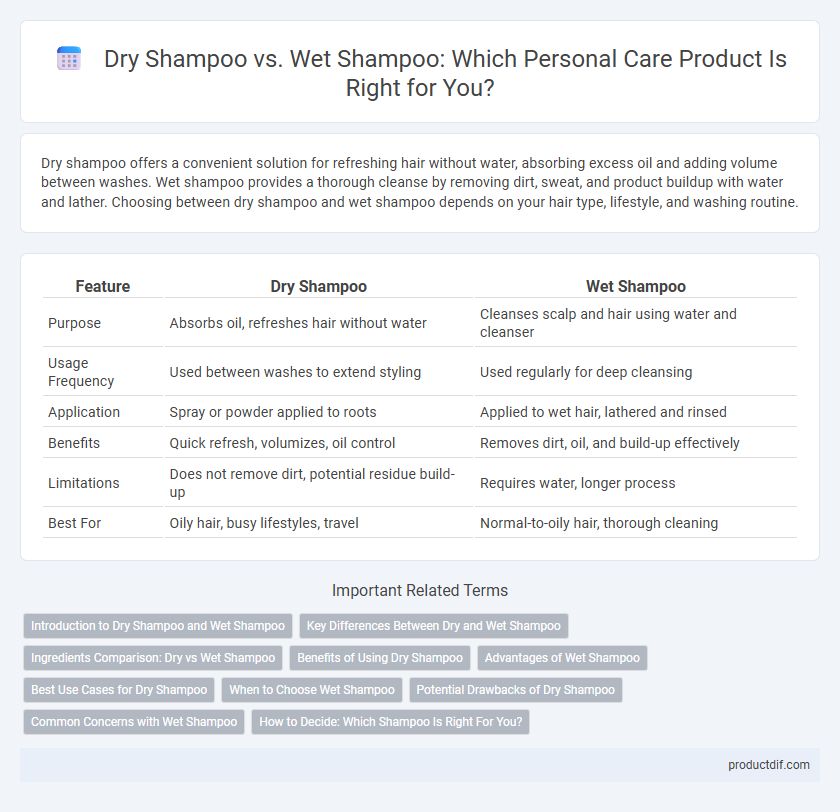Dry shampoo offers a convenient solution for refreshing hair without water, absorbing excess oil and adding volume between washes. Wet shampoo provides a thorough cleanse by removing dirt, sweat, and product buildup with water and lather. Choosing between dry shampoo and wet shampoo depends on your hair type, lifestyle, and washing routine.
Table of Comparison
| Feature | Dry Shampoo | Wet Shampoo |
|---|---|---|
| Purpose | Absorbs oil, refreshes hair without water | Cleanses scalp and hair using water and cleanser |
| Usage Frequency | Used between washes to extend styling | Used regularly for deep cleansing |
| Application | Spray or powder applied to roots | Applied to wet hair, lathered and rinsed |
| Benefits | Quick refresh, volumizes, oil control | Removes dirt, oil, and build-up effectively |
| Limitations | Does not remove dirt, potential residue build-up | Requires water, longer process |
| Best For | Oily hair, busy lifestyles, travel | Normal-to-oily hair, thorough cleaning |
Introduction to Dry Shampoo and Wet Shampoo
Dry shampoo is a water-free product designed to absorb excess oil and refresh hair without the need for washing, making it ideal for quick styling and extended time between washes. Wet shampoo, formulated with cleansing agents and water, effectively removes dirt, oils, and buildup from the scalp and hair during traditional hair washing routines. Both products serve distinct roles in hair care, with dry shampoo offering convenience for on-the-go freshness and wet shampoo providing a thorough cleanse to maintain scalp health.
Key Differences Between Dry and Wet Shampoo
Dry shampoo uses absorbent powders like starch or silica to remove excess oil and grease from the scalp without water, making it ideal for quick refreshment and extending styling time. Wet shampoo requires water and lathers to cleanse hair thoroughly by removing dirt, sweat, and buildup, promoting scalp health and moisture balance. Dry shampoo suits oily hair control and time-saving, while wet shampoo provides deep cleaning and hydration, essential for regular hair care routines.
Ingredients Comparison: Dry vs Wet Shampoo
Dry shampoo typically contains starches or powders like rice starch, silica, or kaolin that absorb excess oil and impurities without water, while wet shampoo features surfactants such as sodium lauryl sulfate or cocamidopropyl betaine that cleanse by emulsifying dirt and oils. Wet shampoos also include conditioning agents and moisturizers like glycerin or panthenol to nourish hair during washing. Dry shampoos prioritize lightweight, oil-absorbing ingredients, making them ideal for quick refreshes without the need for rinsing.
Benefits of Using Dry Shampoo
Dry shampoo offers a quick and convenient solution for refreshing hair without water, reducing the need for frequent washing that can strip natural oils and cause dryness. It effectively absorbs excess oil and sweat, extending the time between washes while maintaining volume and freshness. Ideal for busy lifestyles and travel, dry shampoo helps preserve hair color and scalp health by minimizing overexposure to shampoo ingredients and heat styling.
Advantages of Wet Shampoo
Wet shampoo effectively cleanses the scalp and hair by removing dirt, excess oil, and product buildup, promoting healthier hair growth. It deeply hydrates and nourishes hair strands with essential ingredients, enhancing moisture retention and reducing dryness. Wet shampoo also improves scalp circulation through massage during application, supporting overall scalp health and reducing dandruff.
Best Use Cases for Dry Shampoo
Dry shampoo is ideal for refreshing hair between washes and absorbing excess oil without water, making it perfect for busy mornings or travel. It extends the life of styled hair by reducing the need for daily washing, which helps maintain natural oils and color. Athletes and people with oily scalps benefit from dry shampoo as it quickly revitalizes hair after workouts or physical activity.
When to Choose Wet Shampoo
Wet shampoo is ideal for effectively cleansing the scalp and hair when there is significant buildup from sweat, oils, or styling products. It is best suited for regular washing routines to maintain scalp health and hair hygiene, particularly after workouts or exposure to pollutants. Choose wet shampoo when deep cleaning is necessary to prevent scalp irritation and promote hair growth.
Potential Drawbacks of Dry Shampoo
Dry shampoo can leave residue buildup on the scalp, leading to clogged pores and potential irritation or dandruff. Frequent use may cause hair to appear dull and weighed down, reducing overall hair health and shine. Unlike wet shampoo, dry shampoo does not cleanse the scalp thoroughly, potentially allowing oils and dirt to accumulate over time.
Common Concerns with Wet Shampoo
Wet shampoo often raises concerns about scalp irritation and residue buildup due to the need for water during application. Many users worry about hair becoming overly oily or weighed down if the shampoo is not rinsed thoroughly. Additionally, frequent washing with wet shampoo can strip natural oils, leading to dryness and scalp sensitivity.
How to Decide: Which Shampoo Is Right For You?
Choosing between dry shampoo and wet shampoo depends on your hair type, lifestyle, and specific needs. Dry shampoo is ideal for refreshing oily roots and extending time between washes without water, while wet shampoo deeply cleanses and nourishes your scalp and hair strands. Consider factors like scalp sensitivity, activity level, and time availability to determine which shampoo best supports your hair health and styling routine.
Dry shampoo vs Wet shampoo Infographic

 productdif.com
productdif.com